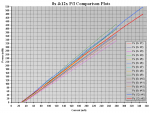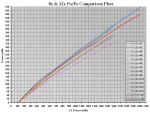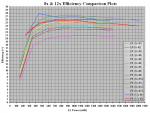I think the efficiency level between 100 and 150ma denotes some significant diode improvements.
None of the 8X diodes approach that efficiency level.
I don't think that's correct, Larry. If you look better at my 8x vs. 12x comparison plots, you'll see that two of the 8x's exceed the second 12x in efficiency and one of the 8x's exceeds the first 12x in efficiency.
The behavior with the strange peak in efficienncy at around 100mA with 12x #1 would be abnormal and a hint that something about the diode is different, if it wasn't most likelly just a measurement error (with the first diode Dave said he wasn't very accurate).
If this was a special characteristic of these diodes, it would repeat itself with the second one, but it didn't. The second 12x does not display a peak like that, and the only reason one of the points in the 12x #2 plot goes above 8x #2 in efficiency is, that it has a data point there, while the 8x doesn't...
There is a short part, where it
seems as if the 12x's have a better efficiency (where they form a "peak", and go above the 8x's, before plunging below them), but that is because Dave measured those 12x's at different steps than i measured the 8x's...
I used 40, 80, 120mA and so on, Dave used 60, 100, 150mA.. As a result, Excel has data points available for 12x's, where there is no data for 8x's and vice versa... These data points are then connected with straight (or smoothed) lines, which can then cross, because there is data in between missing...
Even if 12x's ACTUALLY behaved in this manner - which would be completelly atipical for 405nm diodes - i don't think any real conclusions can be made, until both diode types are compared using the same testing method - same setup, same step size (or accurate higher resolution plots)....
I'm not saying they don't behave like this (altho it would be weird, if they did, because i would indicate poor thermal stability), i'm saying, that the data is not accurate enough to answer this question.
Like i mentioned before - Low resolution testing is more than good enough for P/I (and even Po/Pe) plots which form straight (or nearly straight) lines anyway, but
efficiency plots would benefit from a higher resolution...
If not that, at the very least
they have to be compared using the same method, to allow real comparison...
Don't get me wrong, i was also surprised at the stange efficiency behavior when i first saw it, but i later edited my post, when i realized there is another possible explanation.
There are a few things that play a big factor here..
Dave is using a Rkcstr driver to make plots...
When he turns the pot, the current changes exponentially. The higher he goes, the faster the current changes, and the longer it takes him to dial in a specific one - it's also easier to miss the desired current and make a mistake...
Also, in another thread Dave mentioned, he is without his big test heatsink (which was the same as i use - made by Tallaxo).
This, and the fact that it is harder for him to dial in a specific current means the diode probably warms up faster AND has more time to do so....
That would explain why the 12x's are dropping in efficiency so rapidly at higher currents! They would have to warm up considerably for that, but i guess that's what happened, because i can't believe that IF they are higher power diodes, they would be more sensitive to heat than 8x's!
Again, i'm not saying they are not new higher power diodes, i'm just saying the plots we used for comparison here are simply not good enough....
I do still think the 12X will last a lot longer @ 400mw or higher.
Sharp and Sony both have 320mw laser diodes in production for 12X ...
I think they are 320mw diodes ...
vs. 250mw for the 8X.
LarryDFW
I would love nothing more but for that to be true, and it's still possible, as PullBangDead explained!
But we will have to make better, more accurate tests, because there are too many differences between how the existing tests were done...
This is a big part of the reason PullBangDead keeps saying we should establish a testing protocol people should use, if they want their data to be useful for comparison of various diodes.
And i have an idea...
I still need to test it, but if it works, it would allow anyone with two DMMs and $15 - 25 USD to make a setup that would work the same way as my Diode Analyzer - one pot to set the max current, the other to adjust it LINEARLY from zero to max without the danger of overshooting... It makes plotting a hell of a lot easier!
If it works, i'll post a thread on how to do it, as soon as i find some time...
I just need to test if the required driver is stable enough. If it is, it will work...
P.S. Before i even finished typing this, i soldered one of the drivers required together.
I have to test it on a dummy to see if it can keep the current stable, find the right value pots, and if it works out, i'm sending it to Dave, so he can make plots easier, faster and more accurate at the same time... :yh:







